Union finance minister Arun Jaitley’s Rs.79,686 crore (0.47 percent of GDP) provision for education as the Centre’s contribution for national education is grossly inadequate and completely divorced from the needs of the world’s largest child and youth (550 million) population - Dilip Thakore
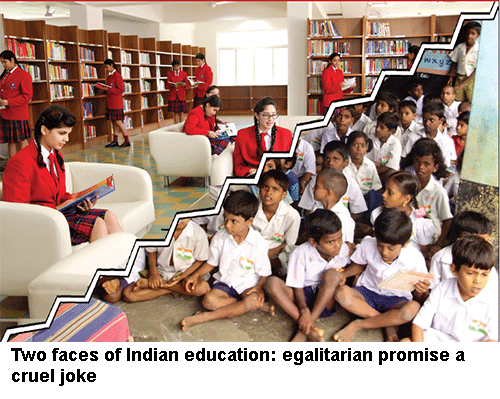 Almost three summers ago when the Bharatiya Janata Party (BJP) led by then three-term Gujarat chief minister Narendra Modi was swept to power in New Delhi with the largest Lok Sabha majority since 1985 and formed the BJP/NDA (National Democratic Alliance) government at the Centre, the general expectation was this unapologetically right-wing party would engineer a clean break with post-independence Nehruvian neta-babu socialism. This inorganic rose-tinted ideology, an impractical brew of the liberal idealism of Britain’s Labour party and Soviet-style central planning in which the State would dominate the “commanding heights of the economy” through a vast number of public sector enterprises, trapped newly independent India, which had a free enterprise tradition of several millennia, into a low-development orbit. Described by the late Prof. Raj Krishna of the Delhi School of Economics, as the ‘Hindu rate’ of growth of 3.5 percent per annum or 1.3 percent per capita for over four decades, it imploded the modest material aspirations of an entire generation of midnight’s children.
Almost three summers ago when the Bharatiya Janata Party (BJP) led by then three-term Gujarat chief minister Narendra Modi was swept to power in New Delhi with the largest Lok Sabha majority since 1985 and formed the BJP/NDA (National Democratic Alliance) government at the Centre, the general expectation was this unapologetically right-wing party would engineer a clean break with post-independence Nehruvian neta-babu socialism. This inorganic rose-tinted ideology, an impractical brew of the liberal idealism of Britain’s Labour party and Soviet-style central planning in which the State would dominate the “commanding heights of the economy” through a vast number of public sector enterprises, trapped newly independent India, which had a free enterprise tradition of several millennia, into a low-development orbit. Described by the late Prof. Raj Krishna of the Delhi School of Economics, as the ‘Hindu rate’ of growth of 3.5 percent per annum or 1.3 percent per capita for over four decades, it imploded the modest material aspirations of an entire generation of midnight’s children.
Under this ideological canopy, the Harrow and Cambridge (natural sciences)-educated Jawaharlal Nehru — independent India’s first prime minister — set about engineering a Centrally planned “socialistic pattern of society” in which industry would be dominated by capital-intensive public sector enterprises. The country’s private business houses (Tata, Birla, Walchand Hirachand, Sarabhai, Mafatlal, Kirloskar, Godrej among others), which had survived the unfair imposts and discrimination of British rule and were poised to propel the economy into a high growth trajectory, were obliged to play second fiddle as per the dictates of an army of business-illiterate ‘committed’ bureaucrats.
Over the past six decades of mainly Congress (the political party which led India’s independence movement) rule, this army of babus at the Centre and in the states has fed upon the land and its people and multiplied into a 20 million-strong Soviet-style nomenklatura (privileged class). And it’s hardly an exaggeration that the paltry gains of the Indian economy over the past seven decades since independence, have been cornered by this privileged tribe. Consequently, the egalitarian society promised by Nehruvian socialism has proved to be a cruel joke played on the gullible people of India. According to Hamid Ansari, the Congress-appointed vice president of India, the top 1 percent of India controls 60 percent of the wealth of the nation, with the bottom 50 percent owning only 2 percent (The Hindu, February 11).
Therefore when the right-wing BJP routed the Congress in General Election 2014, the expectation was this party, which had its support base in the business and trading communities of small-town India, would make a clean break with Nehruvian socialism and restore pre-British India’s free enterprise traditions. This expectation was not unreasonable since prime minister Narendra Modi had cut his political teeth in Gujarat, commonly acknowledged as the country’s most entrepreneurial and business-literate state. However almost three years into its term in office at the Centre, there’s little to distinguish the BJP/NDA administration from its predecessor Congress governments.
The most recent evidence of the bold reform resolutions of prime minister Modi and the BJP running awry, is the Union Budget 2017-18 presented to Parliament and the nation by Union finance minister Arun Jaitley on Februrary 1, as opposed to the traditional date of February 28. But the new date (and amalgamation of the hitherto separate Indian Railways budget into the Union budget) apart, there’s little to distinguish this budget from the rain of Union budgets of preceding Congress finance ministers. Three years on, it’s abundantly clear prime minister Modi and the BJP top brass have been quietly co-opted into the us-first neta-babu brotherhood.
In this connection, it’s worthy of mention that the slogan of Narendra Modi, which most resonated with the electorate was sabka saath sabka vikas (economic development for all). Yet curiously, after this professedly economically right wing and pro-free enterprise government was sworn in on May 26, 2014, it has paid little attention to industry or economic development. In particular, this government has made no effort to privatise any of the 277 Central government public sector enterprises (PSEs), most of whom are in the red, and have been bleeding the economy white for decades.
As your correspondent has been advocating for several decades, the best way to ensure vikas (economic development) is to stage a global auction of PSEs and invest the proceeds in education and health of the world’s largest child and youth population. Although it’s axiomatic that massive investment in human capital development is the surest prescription for economic development as spectacularly demonstrated by countries like South Korea and Singapore, neither the self-serving neta-babu brotherhood nor the “traitorous academics” and intelligentsia, are prepared to propagate this self-evident proposition, or indeed even debate it.
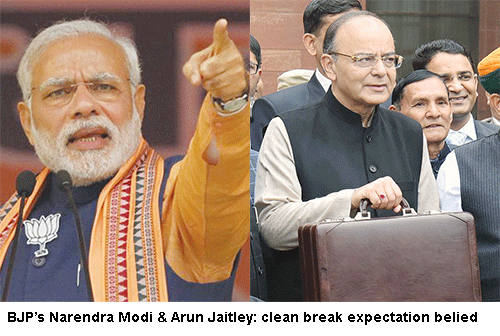 The best the Modi administration has done is to continue the ‘disinvestment’ programme of previous Congress governments under which small dribs and drabs of equity in PSEs are offered to the public, for which there are few takers because which investor in his right mind would majorly invest in PSEs in which government — with its disastrous record of management despite monopoly status — retains ownership and management control? In Budget 2016-17, Jaitley had targeted Rs.56,500 crore from disinvestment of PSEs (a target not achieved) and in Budget 2017-18 more ambitiously, he has budgeted Rs.72,500 crore, also unlikely to be achieved. On the other hand, it should be noted that the market capitalisation of the mostly bleeding Central government PSEs as estimated by Centre for Indian Economy Pvt. Ltd (estb.1976), a highly respected Mumbai-based information company, is Rs.238.82 lakh crore. If carefully marketed and auctioned, they could easily yield Rs.100,000 crore per year for the next three-four years for investment in human capital development, which could transform and secure the future of the Indian economy (see p.86).
The best the Modi administration has done is to continue the ‘disinvestment’ programme of previous Congress governments under which small dribs and drabs of equity in PSEs are offered to the public, for which there are few takers because which investor in his right mind would majorly invest in PSEs in which government — with its disastrous record of management despite monopoly status — retains ownership and management control? In Budget 2016-17, Jaitley had targeted Rs.56,500 crore from disinvestment of PSEs (a target not achieved) and in Budget 2017-18 more ambitiously, he has budgeted Rs.72,500 crore, also unlikely to be achieved. On the other hand, it should be noted that the market capitalisation of the mostly bleeding Central government PSEs as estimated by Centre for Indian Economy Pvt. Ltd (estb.1976), a highly respected Mumbai-based information company, is Rs.238.82 lakh crore. If carefully marketed and auctioned, they could easily yield Rs.100,000 crore per year for the next three-four years for investment in human capital development, which could transform and secure the future of the Indian economy (see p.86).
Indeed, the best evidence of the drift of the BJP from its right-wing private enterprise moorings is provided by this party’s reluctance — despite overwhelming media consensus — to privatise the continuously loss-making Air India. Currently this over-manned parking lot for kith and kin of every half-influential politician and bureaucrat, has run up an enormous cumulative loss of over Rs.50,000 crore despite several bailouts by government. Instead of forthrightly and unequivocally privatising Air India, the latest hare-brained scheme of the Modi government is to convert the Rs.50,000-crore debt of this nationalised airline into equity to be subscribed by 19 nationalised banks which are already stressed by huge NPAs (non-performing assets).
Quite obviously despite the BJP’s pro-business credentials, the party leaders prefer the status quo in Air India, so they can enjoy the power and perks of this pathetic PSE which is a massive drain on public resources. For similar pork barrel reasons, the BJP has been reduced to half-heartedly ‘disinvesting’ its equity in PSEs for which the main takers are public sector financial PSEs and nationalised banks.
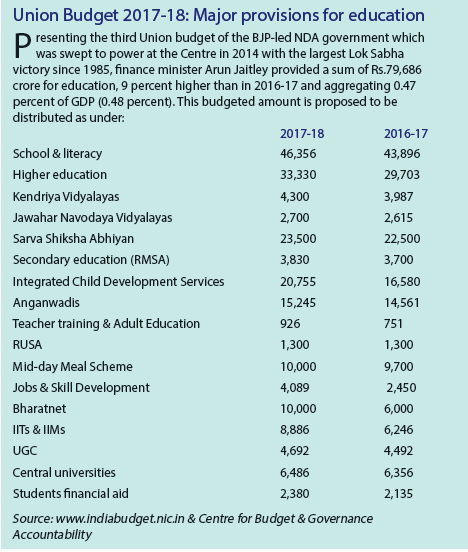 The conspicuous failure of the BJP/NDA government to privatise PSEs to mobilise low-hanging resources for investment in human capital development is compounded by the huge expense of maintaining New Delhi’s neta-babu brotherhood — regardless of the party in power at the Centre — in the vice-regal style of the erstwhile nabobs of the British Raj. In this connection, it’s important to note that the humungous amount of the Centre’s tax revenue the Union government spends on itself by way of salaries and wages of its 4 million lackadaisical employees and establishment expenses has been a well-kept secret ever since India attained its political independence in 1947.
The conspicuous failure of the BJP/NDA government to privatise PSEs to mobilise low-hanging resources for investment in human capital development is compounded by the huge expense of maintaining New Delhi’s neta-babu brotherhood — regardless of the party in power at the Centre — in the vice-regal style of the erstwhile nabobs of the British Raj. In this connection, it’s important to note that the humungous amount of the Centre’s tax revenue the Union government spends on itself by way of salaries and wages of its 4 million lackadaisical employees and establishment expenses has been a well-kept secret ever since India attained its political independence in 1947.
Astonishingly, the huge annual wages, salaries and overheads bill of the Central government has been concealed in the Union budget under the heads of recurring and revenue expenditure, and has never been seriously protested by the country’s over-hyped free press, indolent academics or intelligentsia. However — perhaps coincidentally — after EducationWorld strongly criticised past Union budgets for their opacity and concealment of the establishment expenses of the Union government, and filed an application to the finance ministry under the Right to Information Act, 2005 demanding details of the Central wages and salaries bill, the Union Budget 2017-18 discloses Rs.4.37 lakh crore, equivalent to 20 percent of the Centre’s total expenditure of Rs.21.46 lakh crore next year, under the head of ‘establishment expenditure of Centre’. Of this huge amount, an estimated Rs.2.5 lakh crore (after the generous award of the Seventh Pay Commission in November 2015) is the wages, salaries, perquisites bill of the 4 million employees of the Central government.
In particular, it needs to be noted that the foreign and domestic business travel perquisite of politicians and bureaucrats is heavily abused and billed to the public exchequer. During his undistinguished two terms in office, Congress-UPA prime minister Manmohan Singh ran up the highest foreign travel bill in Indian history, and in his very first year in office, prime minister Modi billed the public Rs.37 crore for his foreign tours.
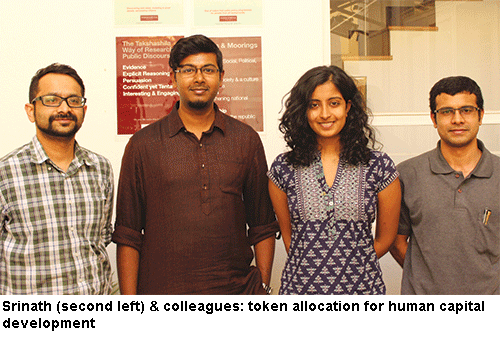 Nor is foreign travel at will the prerogative of heads of government. There is no official record of the number of times ministers and babus travel in India and abroad, but the aggregate bill of their peregrinations is certain to be staggering. Dr. Pallam Raju served as the Union human resource development minister of the unlamented Congress/UPA II government for only 19 months. But every time (which was often) your editor rang for an appointment, he was abroad. Moreover, an India Today RTI application to the Union government revealed that during the second term of the Congress/UPA government (2009-2014), Dr. Montek Singh Ahluwalia, deputy chairman of the Planning Commission (India), travelled abroad at an average of every nine days at public expense. It’s a telling commentary on the quality of Indian democracy and its professedly autonomous institutions, including the media and academia, that the extravagance and self-indulgence of successive governments hasn’t been sufficiently protested or questioned.
Nor is foreign travel at will the prerogative of heads of government. There is no official record of the number of times ministers and babus travel in India and abroad, but the aggregate bill of their peregrinations is certain to be staggering. Dr. Pallam Raju served as the Union human resource development minister of the unlamented Congress/UPA II government for only 19 months. But every time (which was often) your editor rang for an appointment, he was abroad. Moreover, an India Today RTI application to the Union government revealed that during the second term of the Congress/UPA government (2009-2014), Dr. Montek Singh Ahluwalia, deputy chairman of the Planning Commission (India), travelled abroad at an average of every nine days at public expense. It’s a telling commentary on the quality of Indian democracy and its professedly autonomous institutions, including the media and academia, that the extravagance and self-indulgence of successive governments hasn’t been sufficiently protested or questioned.
Comments Pavan Srinath, a fellow of the Takshashila Institution (estb. 2011), a Bangalore-based think tank focused on public policy research and education: “The provision of Rs.4.37 lakh crore for the establishment expenses of the Central government is a full 20 percent of the total expenditure — a huge amount. A large chunk of establishment expenditure comprises government salaries and perquisites of thousands of employees with permanent tenure doing redundant jobs. Outside of the establishment expenditure, more salary expenditure is incurred in the defence budget, and in central schemes. Opaque accounting systems and inadequate disclosure norms bloat establishment expenditure. Beyond salaries, a full Rs.1.31 lakh crore — 6 percent of the total budget — is spent on pensions payable to retired civil servants — stemming from government pensions policies being too generous, ill-planned and suited to an era of much shorter lifespans. Beyond this, a full 25 percent of government expenditure is incurred by way of interest on loans taken by government. Together, over half the Union government budget is spent on establishment costs, salaries, pensions and interest payouts.”
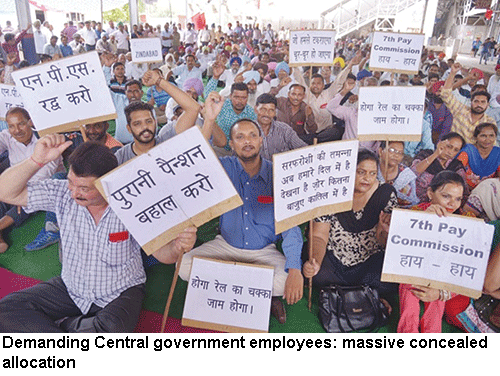 According to Srinath, an alumnus of IIT-Madras who started his public policy career with the late Dr. Samuel Paul’s Public Affairs Centre in 2010, and joined Takshashila three years later, there’s no check on the Centre’s establishment expenses and overheads because successive administrations in Delhi have ignored the numerous reports of the Administrative Reforms Commission as also of Pay Commissions to rationalise manpower, introduce accountability and productivity norms within the Central civil services. “With the New Delhi establishment unwilling to rein in its revenue expenditure, privatise bleeding public sector enterprises and slash unmerited subsidies, it’s unsurprising that Union Budgets make token allocations — completely divorced from need — for human capital development,” says Srinath.
According to Srinath, an alumnus of IIT-Madras who started his public policy career with the late Dr. Samuel Paul’s Public Affairs Centre in 2010, and joined Takshashila three years later, there’s no check on the Centre’s establishment expenses and overheads because successive administrations in Delhi have ignored the numerous reports of the Administrative Reforms Commission as also of Pay Commissions to rationalise manpower, introduce accountability and productivity norms within the Central civil services. “With the New Delhi establishment unwilling to rein in its revenue expenditure, privatise bleeding public sector enterprises and slash unmerited subsidies, it’s unsurprising that Union Budgets make token allocations — completely divorced from need — for human capital development,” says Srinath.
But be that as it may, for the purposes of review and analysis of Union Budget 2017-18, it must be noted that the budgeted total expenditure of the Central government is Rs.21.46 lakh crore. Of this, Rs.9.7 lakh crore is allocated for establishment expenditure (including Rs.5.33 lakh crore under the head ‘others’). If to this sum is added the Rs.3.59 lakh crore proposed to be spent on defence, it’s hardly surprising that the provision for education to build the foundation for human capital development, is pathetically inadequate.
In Budget 2017-18, the Central government’s outlay for public education is Rs.79,686 crore. Although this is 9 percent higher than in 2016-17, it’s lower than the Rs.82,771 crore budgeted (but not spent) by the UPA-II government in 2015-16, and aggregates a mere 0.47 percent of GDP (0.48 in 2016-17). In the current year (2016-17), the Centre’s allocation for education was set at Rs.72,394 crore on the argument that with the share of the Centre’s allocation for state governments from its tax revenue having been increased by 10 percent by the 14th Finance Commission, the states would spend more on education.
But as revealed by Public Financing of School Education in India: A Fact Sheet (2016), a national study jointly conducted by the Delhi-based think-tank Centre for Budget & Governance Accountability (CBGA) and CRY (Child Rights & You), state governments are even more neglectful of education. The study notes that in Madhya Pradesh, West Bengal, Andhra Pradesh (undivided), Maharashtra, Karnataka and Tamil Nadu, the size of school budgets for public education as a proportion of GSDP (gross state domestic product including all Central government grants) have declined between 2012-13 and 2015-16. Only Bihar and Uttar Pradesh budgeted more than 5 percent of GSDP for public education in 2015-16, but are unlikely to have achieved that target.
Indeed, informed monitors of India’s languishing education sector are almost unanimous that for the country to achieve meaningful economic development the annual education expenditure should be 6 percent (Centre plus states) of GDP as recommended by the high-powered Kothari Commission way back in 1966. To attain this target, the Centre’s budgetary outlay for education needs to be six times the current Rs.79,686 crore per year (i.e, Rs.4.78 lakh crore), with the remaining Rs.5.32 lakh crore to be contributed by state governments. In this context, it’s worthwhile to note that global average national expenditure on education is 5 percent of GDP with the developed OECD countries spending 7-10 percent of GDP on public education.
Yet perhaps the greatest infirmity of the budgetary process in independent India is that sectoral allocations are made without any assessment of actual need. The result is that small dribs and drabs of money difficult to monitor and mostly consumed by administrative costs and leakages, is spread over a vast number of projects. Such budgetary efforts to please all, culminate in pleasing none.
A classic instance is provided by the allocation for early childhood care and education (ECCE) which curiously falls within the administrative jurisdiction of the Union ministry of women and child development (WCD). Budget 2017-18 provides a sum of Rs.22,095 crore for the WCD ministry’s ICDS (Integrated Child Development Services) programme which manages 1.34 million anganwadis — essentially nutrition centres for lactating mothers and newborns. Currently, only 80 million of India’s 164 million children under age-5 are admitted into anganwadis. But the provision made by the latest Union budget is only a token 4.7 percent higher at Rs.15,245 crore, a mere Rs.1,906 per year per capita for the 80 million children in anganwadis, with the remaining 84 million infants beyond the ambit of the ICDS programme.
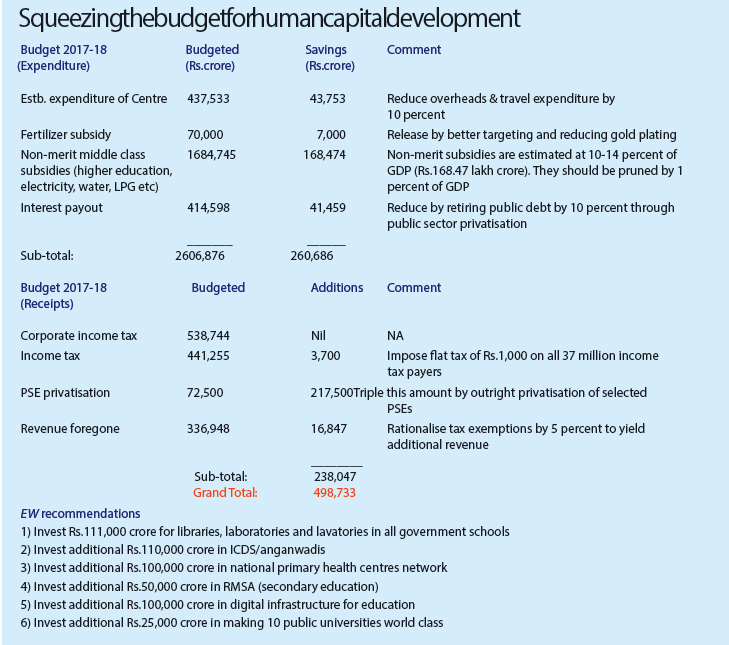 Similarly, token increments which barely cover price inflation are doled out in Budget 2017-18 for the Sarva Shiksha Abhiyaan (primary education for all) programme which is allocated Rs.23,500 crore (Rs.22,500 crore in 2016-17 against the Rs.55,000 crore approved by the Union HRD ministry); Rs.3,830 crore for public secondary education; Rs.1,300 crore for RUSA (a programme for higher education), and a mere Rs.986 crore for teacher training and adult education (see box p.84). Quite obviously, the overall provision made by finance minister Arun Jaitley of Rs.79,686 crore in the latest Budget as the Central government’s contribution for national education is grossly inadequate and completely divorced from the needs of the world’s largest (550 million) child and youth population.
Similarly, token increments which barely cover price inflation are doled out in Budget 2017-18 for the Sarva Shiksha Abhiyaan (primary education for all) programme which is allocated Rs.23,500 crore (Rs.22,500 crore in 2016-17 against the Rs.55,000 crore approved by the Union HRD ministry); Rs.3,830 crore for public secondary education; Rs.1,300 crore for RUSA (a programme for higher education), and a mere Rs.986 crore for teacher training and adult education (see box p.84). Quite obviously, the overall provision made by finance minister Arun Jaitley of Rs.79,686 crore in the latest Budget as the Central government’s contribution for national education is grossly inadequate and completely divorced from the needs of the world’s largest (550 million) child and youth population.
But the great Indian conundrum is why year after year education, which as all studies of the history of OECD nations prove is the foundation for realising the country’s boundless potential, has been neglected for almost seven decades after India became a sovereign independent republic. Rather than the shop-worn excuse of paucity of resources routinely advanced, it’s the skewed priorities of all governments at the Centre and the states which are to blame.
As has been argued above, massive investible resources are deadlocked in the country’s wasteful public sector enterprises, which if judiciously sold could easily raise Rs.100,000 crore per annum for the next three-four years for investment in education and health. Moreover, unmerited middle class subsidies (fertiliser, water, electricity, higher education etc) and numerous tax exemptions given to industry which according to former Union finance minister P. Chidambaram aggregate 14 percent of GDP, offer great resource mobilisation and deployment opportunities. (see box p.86)
The plain truth is that despite the history of all developed nation states and our own ancient civilisation clearly demonstrating that a well-educated populace is the prerequisite of national development, neither the country’s 20 million-strong neta-babu brotherhood which has a stranglehold over the country, nor the 200 million-strong middle class is bothered about educating the vast majority of the population. While it’s obvious that the brotherhood is content with a vast pool of illiterate and ill-educated citizens because they are a gullible vote bank for the country’s corrupt and self-serving political class, and the acquisitive middle class is also insufficiently educated to discern the link between universal literacy and economic development, the indifference of the intelligentsia — including the media — is puzzling.
Well-served by the private school — and increasingly private higher education — systems, they seem unable to grasp the reality that the fanciful dreams it nurtures about 21st century India emerging as a global super-power will remain a fantasy unless and until the crumbling public education system is vastly improved. This is the necessary precondition of raising contemporary India’s government, agriculture and industrial productivity which is arguably the lowest worldwide.
Therefore unless strong and sustained pressure is exerted by the middle class, academia and the intelligentsia to move education to the top of the national development agenda, 21st century India will remain an also-ran nation state with a vast illiterate, ill-educated and unskilled subaltern citizenry struggling in shallows and misery.
Union Budget 2017-18 reactions
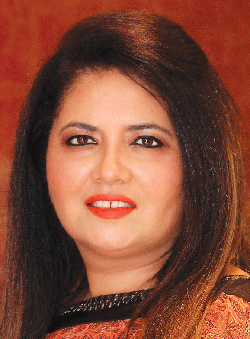 The measures announced in the budget will provide much needed impetus to the education and skill development sectors in the country — Monica Malhotra Kandhari, Managing Director, MBD Group, Delhi
The measures announced in the budget will provide much needed impetus to the education and skill development sectors in the country — Monica Malhotra Kandhari, Managing Director, MBD Group, Delhi
 It’s encouraging to see the government’s announcement to set up 100 India international skill centres and a budget of Rs.2,200 crore set aside for investment in vocational training. It will push the Skill India drive and help in creating more employment for skilled youth — Prof. Atmanand, MDI, Gurgaon
It’s encouraging to see the government’s announcement to set up 100 India international skill centres and a budget of Rs.2,200 crore set aside for investment in vocational training. It will push the Skill India drive and help in creating more employment for skilled youth — Prof. Atmanand, MDI, Gurgaon
 The allocations made for promotion of education through online technologies is a substantial initiative and has been accorded perhaps the greatest emphasis of any Union budget, and has the potential of creating a tectonic impact in getting more children into the education net. But failure to open up the education sector to foreign direct investment is disappointing — Shantanu Prakash, Managing Director, Educomp Solutions Ltd
The allocations made for promotion of education through online technologies is a substantial initiative and has been accorded perhaps the greatest emphasis of any Union budget, and has the potential of creating a tectonic impact in getting more children into the education net. But failure to open up the education sector to foreign direct investment is disappointing — Shantanu Prakash, Managing Director, Educomp Solutions Ltd
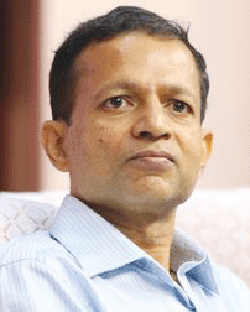 Indian higher ed institutions need to develop into hubs of innovation and excellence in research and find their rightful place in international rankings of top institutions. This budget has made welcome moves in that direction — Dr. P. Venkat Rangan, Vice Chancellor, Amrita University, Coimbatore
Indian higher ed institutions need to develop into hubs of innovation and excellence in research and find their rightful place in international rankings of top institutions. This budget has made welcome moves in that direction — Dr. P. Venkat Rangan, Vice Chancellor, Amrita University, Coimbatore
 SWAYAM got a special mention as the latest digital initiative of the government. It shows the high priority the government accords towards promoting technology-based learning. This additional focus on advanced skills development and preparing a global workforce through India international skills centres is a very welcome step — Vijay K. Thadani, vice chairman & Managing Director, NIIT Ltd, Delhi
SWAYAM got a special mention as the latest digital initiative of the government. It shows the high priority the government accords towards promoting technology-based learning. This additional focus on advanced skills development and preparing a global workforce through India international skills centres is a very welcome step — Vijay K. Thadani, vice chairman & Managing Director, NIIT Ltd, Delhi
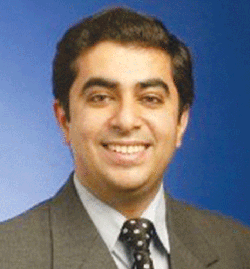 Focus on monitoring and improving learning outcomes through investment in ICT-enabled transformation is expected to have a far reaching impact on improving quality, equity and access of education in the country — Rohin Kapoor, Director, Deloitte Haskins & Sells LLP, Delhi
Focus on monitoring and improving learning outcomes through investment in ICT-enabled transformation is expected to have a far reaching impact on improving quality, equity and access of education in the country — Rohin Kapoor, Director, Deloitte Haskins & Sells LLP, Delhi